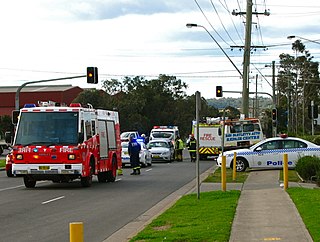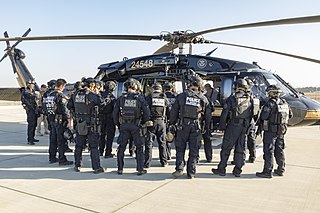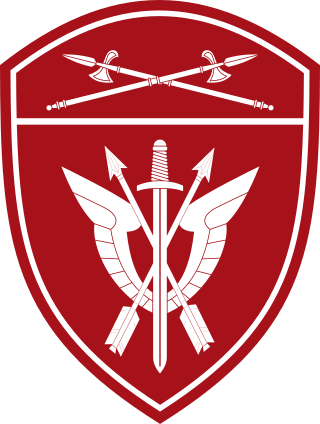A medical emergency is an acute injury or illness that poses an immediate risk to a person's life or long-term health, sometimes referred to as a situation risking "life or limb". These emergencies may require assistance from another, qualified person, as some of these emergencies, such as cardiovascular (heart), respiratory, and gastrointestinal cannot be dealt with by the victim themselves. Dependent on the severity of the emergency, and the quality of any treatment given, it may require the involvement of multiple levels of care, from first aiders through emergency medical technicians, paramedics, emergency physicians and anesthesiologists.

Emergency services and rescue services are organizations that ensure public safety, security, and health by addressing and resolving different emergencies. Some of these agencies exist solely for addressing certain types of emergencies, while others deal with ad hoc emergencies as part of their normal responsibilities. Many of these agencies engage in community awareness and prevention programs to help the public avoid, detect, and report emergencies effectively. Emergency services are often considered first responders, and typically have dedicated emergency vehicles.

In the United States, a SWAT team is a generic term for a police tactical unit.

A first responder is a person with specialized training who is among the first to arrive and provide assistance or incident resolution at the scene of an emergency. First responders typically include law enforcement officers, emergency medical services members, fire service members and Public Works employees such as Heavy Equipment Operators as well as Public Works Tree Department personnel. In some jurisdictions, emergency department personnel, such as doctors and nurses, are also required to respond to disasters and critical situations, designating them first responders; in other jurisdictions, military and security forces may also be authorized to act as first responders.
Human decontamination is the process of removing hazardous materials from the human body, including chemicals, radioactive substances, and infectious material.

Disaster response refers to the actions taken directly before, during, or immediately after a disaster. The objective is to save lives, ensure health and safety, and meet the subsistence needs of the people affected. It includes warning and evacuation, search and rescue, providing immediate assistance, assessing damage, continuing assistance, and the immediate restoration or construction of infrastructure. An example of this would be building provisional storm drains or diversion dams. Emergency response aims to provide immediate help to keep people alive, improve their health and support their morale. It can involve specific but limited aid, such as helping refugees with transport, temporary shelter, and food. Or it can involve establishing semi-permanent settlements in camps and other locations. It may also involve initial repairs to damage to infrastructure, or diverting it.

The Special Rapid Response Unit or SOBR, from 2002 to 2011 known as OMSN, is a spetsnaz unit of the National Guard of Russia (Rosgvardiya).

A Disaster Medical Assistance Team (DMAT) is a specialized group under the National Disaster Medical System (NDMS), part of the U.S. Department of Health and Human Services. These teams are composed of professional medical personnel including physicians, physician assistants (PA), nurses, paramedics, pharmacists, and logistical and administrative support staff. DMATs are deployed to provide rapid-response medical care, support hospitals with excess patient loads, and engage in patient triage and emergency care during significant incidents such as natural disasters, terrorist attacks, disease outbreaks, and national special security events.

The Hamilton Police Service (HPS) is the police service of the city of Hamilton, Ontario, Canada. As of 2021, the service employed 829 sworn officers and 414 non-sworn staff, serving a population of about 570 000 residents. The service's headquarters are located at 155 King William St., Hamilton, Ontario. As of 2022, the service's budget is $183 542 539, roughly 18.5% of the City's overall budget. It is one of the oldest police forces in Ontario.

The Border Patrol Tactical Unit (BORTAC) is one of two police tactical units in the Special Operations Group, under the United States Border Patrol (USBP) that specialize in counterterrorism, high-risk tactical law enforcement situations, hostage rescue, operating in difficult to access terrain, reconnaissance, and tactical special operations. In 2007, BORTAC was placed under the command of the newly formed Special Operations Group (SOG) together with the Border Patrol Search, Trauma, and Rescue (BORSTAR).
An emergency service unit (ESU), alternatively emergency service detail (ESD) or emergency service squad (ESS), is a type of unit within an emergency service, usually police, that is capable of responding to and handling a broader or more specific range of emergencies and calls for service than regular units within their organization, such as rescue, emergency management, and mass casualty incidents. They are similar to police tactical units, fire department technical rescue, and incident response teams in other emergency services and organizations, and often have similar or overlapping roles; the term is also used synonymously for these units, or as a catch-all for units that combine multiple disciplines and roles under one banner.

An active shooter is the perpetrator of an ongoing mass shooting. The term is primarily used to characterize shooters who are targeting victims indiscriminately and at a large scale, who oftentimes, will either commit suicide or intend to be killed by police. More generally, an active perpetrator of a mass murder may be referred to as an active killer.
Hospital emergency codes are coded messages often announced over a public address system of a hospital to alert staff to various classes of on-site emergencies. The use of codes is intended to convey essential information quickly and with minimal misunderstanding to staff while preventing stress and panic among visitors to the hospital. Such codes are sometimes posted on placards throughout the hospital or are printed on employee identification badges for ready reference.

The Dienst Speciale Interventies, commonly abbreviated DSI, is the elite police tactical unit of the Dutch National Police Corps and was formally established on 1 July 2006. The DSI is tasked with neutralizing terrorist incidents and other violent public order disruptions for which regular police units are inadequately equipped. In total, the DSI consists of about 600 active personnel.

A mass casualty incident describes an incident in which emergency medical services resources, such as personnel and equipment, are overwhelmed by the number and severity of casualties. For example, an incident where a two-person crew is responding to a motor vehicle collision with three severely injured people could be considered a mass casualty incident. The general public more commonly recognizes events such as building collapses, train and bus collisions, plane crashes, earthquakes and other large-scale emergencies as mass casualty incidents. Events such as the Oklahoma City bombing in 1995, the September 11 attacks in 2001, and the Boston Marathon bombing in 2013 are well-publicized examples of mass casualty incidents. The most common types of MCIs are generally caused by terrorism, mass-transportation accidents, fires or natural disasters. A multiple casualty incident is one in which there are multiple casualties. The key difference from a mass casualty incident is that in a multiple casualty incident the resources available are sufficient to manage the needs of the victims. The issue of resource availability is therefore critical to the understanding of these concepts. One crosses over from a multiple to a mass casualty incident when resources are exceeded and the systems are overwhelmed.

The National Disaster Response Force (NDRF) is a specialized force in India, tasked with the responsibility of responding to natural and man-made disasters. It operates under the National Disaster Management Authority of Ministry of Home Affairs and was established in 2006 with the aim of strengthening disaster management capabilities in the country

National Response Scenario Number One is the United States federal government's planned response to a small scale nuclear attack. It is one of the National Response Scenarios developed by the United States Department of Homeland Security, considered the most likely of fifteen emergency scenarios to impact the United States. The Scenarios are related to the National Response Framework (NRF), which describes the structures and mechanisms of a response and the National Incident Management System (NIMS) that gives a framework to orchestrate emergency management. The scenario anticipates terrorists detonating a single, 10 kiloton weapon in a major city, as opposed to a full-scale nuclear war, in which a foreign power such as Russia or China would detonate hundreds or thousands of weapons.

Tactical Emergency medical services (TEMS) is out-of-hospital care given in hostile situations by specially trained practitioners. Tactical support provided through TEMS can be applied in either the civilian world, generally with special law enforcement teams such as SWAT and SERT, as well as with military special operations teams. Tactical EMS providers are paramedics, nurses, and physicians who are trained to provide life-saving care and, sometimes, transport in situations such as tactical police operations, active shooters, bombings, and natural disasters. Tactical medical providers (TMPs) provide care in high risk situations where there is an increased likelihood for law enforcement, civilian, or suspect casualties. TEMS units are also deployed in situations where traditional EMS or firefighters cannot respond. TMPs are specially trained and authorized to perform live-saving medical procedures in austere and often times unconventional environments. TMPs are also expected to be competent in weapons safety and marksmanship, small unit tactics, waterborne operations, urban search and rescue, and HAZMAT. TMPs also serve to train their respective teams in complex medical procedures that may be performed in their absence. TEMS providers are sometimes sworn police officers cross trained as paramedics, paramedics that are operators trained and integrated into the SWAT Team, or medical providers trained in tactical EMS who are then integrated into law enforcement or military units.

A crisis actor is a trained actor, role player, volunteer, or other person engaged to portray a disaster victim during emergency drills to train first responders such as police, firefighters or EMS personnel. Crisis actors are used to create high-fidelity simulations of disasters in order to allow first responders to practice their skills and help emergency services to prepare and train in realistic scenarios as part of full-scale disaster exercises. The term has also been used by conspiracy theorists who claim that some mass shootings and other terror events are staged for the advancement of various political objectives.

Active shooter training addresses the threat of an active shooter by providing awareness, preparation, prevention, and response methods.















